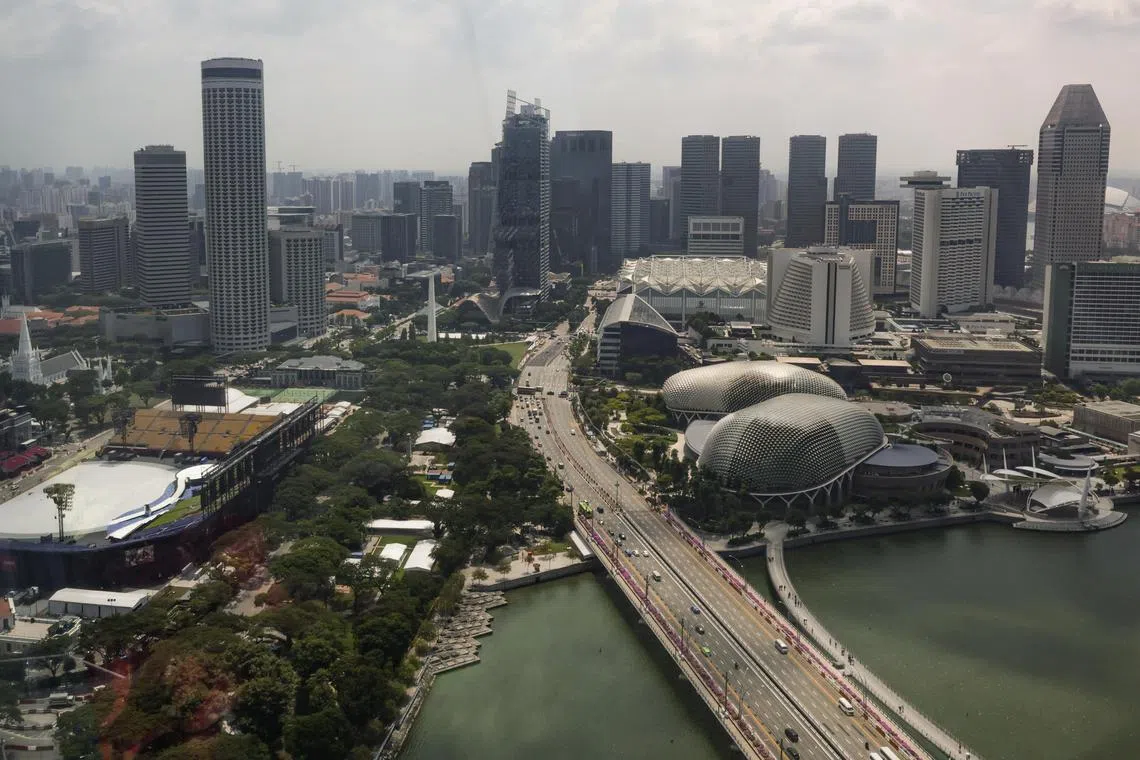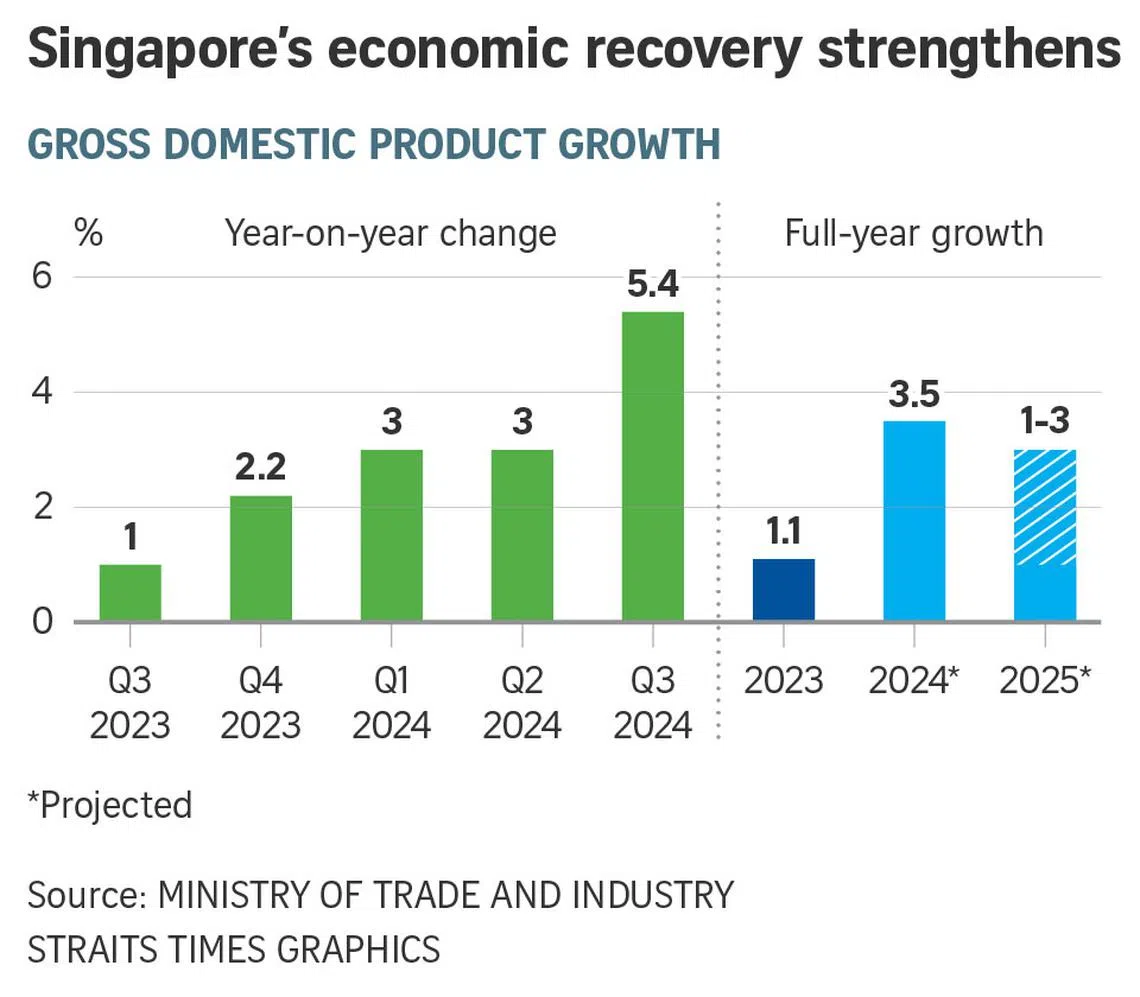S’pore raises 2024 growth forecast, but sees economy slowing in 2025 from global uncertainties
Sign up now: Get ST's newsletters delivered to your inbox

The third-quarter growth beat both the official advanced estimate of a 4.1 per cent and the upwardly revised 3 per cent expansion in the second quarter.
ST PHOTO: GIN TAY
Follow topic:
SINGAPORE – Singapore’s economy blew past estimates for third-quarter growth, leading the Government to raise its forecast for the full year of 2024.
But it also tipped growth in 2025 to slow to a range of 1 per cent to 3 per cent, reflecting heightened global uncertainties generated by Donald Trump’s return to the White House, further escalation of conflicts in the Middle East and Ukraine, and China’s continuing slowdown.
The official 2024 growth forecast was raised to “around 3.5 per cent” from a previous range of 2 per cent to 3 per cent, after third-quarter growth accelerated to 5.4 per cent – the strongest year-on-year growth since the fourth quarter of 2021 and higher than the 4.1 per cent initial estimate.
The full-year upgrade marks a strong rebound from 2023, when the economy grew just 1.1 per cent.
“On balance, Singapore’s overall external demand outlook is expected to remain resilient for the rest of 2024,” the Ministry of Trade and Industry (MTI) said on Nov 22.
“Growth in the third quarter was primarily driven by the manufacturing, wholesale trade, and finance and insurance sectors, which were bolstered in part by the upturn in the global electronics cycle,” Permanent Secretary for Trade and Industry Beh Swan Gin said at a media briefing.
It brought the growth for the first three quarters to 3.8 per cent year on year, compared with 0.7 per cent for the same period in 2023, said Ms Selena Ling, OCBC Bank’s chief economist.
Dr Beh said: “Given the strong momentum going into the remaining quarter of the year, we cannot rule out the possibility that GDP (gross domestic product) growth could exceed 3.5 per cent this year.”
But for 2025, MTI noted, risks have “tilted to the downside”.
A big one is a potential barrage of tariffs from the new Trump administration, which would affect the economies of Singapore’s trading partners. US President-elect Trump has said he wants to slap tariffs of 60 per cent on imports from China and 20 per cent on imports from the rest of the world.
While Trump is likely to impose tariffs, the “US enjoys a trade surplus with Singapore, so that is a positive for us”, Mr Beh said.
The US accounts for more than 10 per cent of Singapore’s trade and more than 20 per cent of the Republic’s investments.
Other downside risks include a further escalation of geopolitical conflicts
Disruptions to the global disinflation process could lead to tighter financial conditions, potentially triggering latent vulnerabilities in financial systems, MTI added.
The result is that overall economic growth in Singapore’s key trading partners like the US is expected to ease slightly from the level in 2024.
“Against this backdrop, the growth outlook of the manufacturing sector and trade-related services sectors in Singapore remains positive,” Dr Beh said.
The electronics cluster is projected to continue to expand, supported by strong global semiconductor demand. This will have positive spillover effects on the precision engineering cluster and the wholesale trade sector.
At the same time, firm order books for the aerospace and marine and offshore engineering industries should drive growth in the transport engineering cluster.
Outward-oriented services sectors, such as the information and communications, and finance and insurance industries, are projected to register healthy growth.
Tourism-related sectors like the accommodation sector will benefit from the continued recovery in international visitor arrivals, Dr Beh added.
But the slump in the retail and food and beverage industries is likely to continue on more locals travelling overseas and the slower-than-expected recovery in international visitor arrivals and tourism spending.

UOB associate economist Jester Koh lowered his 2025 growth forecast to 2.5 per cent from 2.9 per cent on risks to Singapore’s external outlook.
OCBC’s Ms Ling is keeping her 2.7 per cent growth projection for 2025.
DBS Bank economist Chua Han Teng maintained his 2025 prediction at 2.8 per cent.
Growth will be underpinned by the ongoing global tech and electronics upcycle and the gradual cut in interest rates, he said.
He expects these global drivers to spill over positively to Singapore’s external-oriented sectors, namely manufacturing, wholesale trade, transport and storage, finance and insurance, and information and communications.
While Mr Chua is still expecting the Singapore economy to grow in 2025 – like MTI, barring the materialisation of downside risks – he noted that during Trump’s first presidency from 2017 to 2021, higher tariffs and heightened policy uncertainty resulted in a global economic slowdown.
Singapore’s own growth slowed to below 2 per cent year on year from the fourth quarter of 2018 before bottoming out at 0.8 per cent in the third quarter of 2019, prior to the Covid-19 pandemic.
While a technical recession was avoided, sequential quarter-on-quarter seasonally adjusted growth was weak, averaging at just 0.1 per cent in the second half of 2019, compared with 0.6 per cent in the first half of the same year.


